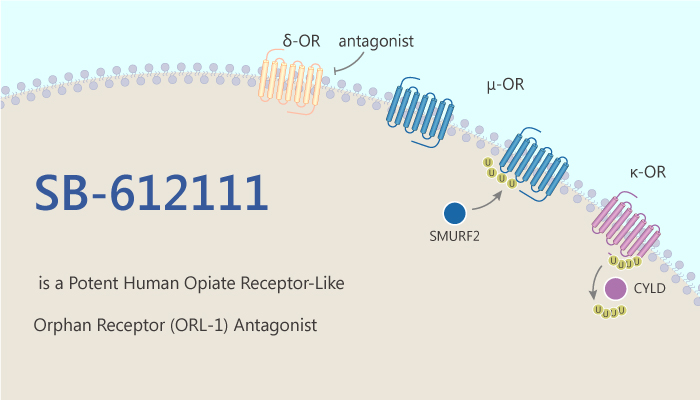Nociceptin, as a 17-amino acid peptide, is a potent endogenous agonist for the opiate receptor-like orphan receptor (ORL-1). It exhibits a high degree of structural homology to the classical opioid receptors. Activation of the ORL-1 receptor with nociceptin enhances cellular K conductance and inhibits Ca2+ currents associates with N, L, and P/Q calcium channel
activation and blocks cellular cAMP production.
Several ORL-1 receptor antagonists have been described to clarify their physiological roles. ORL-1 receptor antagonists, such as JTC-801, antagonize the nociceptin-mediated inhibition
of cAMP production. In addition, JTC-801 can block nociceptin-induced pronociceptive effects.
In this article, we will introduce a high-affinity and broadly selective ORL-1 receptor, SB-612111.
SB-612111 is a novel and potent human opiate receptor-like orphan receptor (ORL-1) antagonist. It has a high affinity for hORL-1 (Ki=0.33 nM). SB-612111 exhibits selectivity for μ-, κ- and δ-receptors with Ki values of 57.6 nM, 160.5 nM, and 2109 nM, respectively.
In Male rats, SB-612111 antagonize nociceptin-induced thermal hyperalgesia in a dose-dependent manner with an ED50 of 0.62 mg/kg. In addition, it causes significant inhibition of the carrageenan-induced reduction in paw withdrawal latencies. However, the untreated paw is unaffected. SB-612111 effectively antagonizes the pronociceptive action of Nociceptin (HY-P0183) in an acute pain model.

SB-612111 is a novel class of nonpeptide antagonists and its structure does not relate to other nonpeptide ORL-1 receptor ligands.
In a competition radioligand binding experiment, SB-612111 shows its preference for the ORL-1 receptor. Besides, when compares with other ORL-1 receptor ligands, SB-612111 has a higher affinity for the ORL-1 receptor and greater selectivity. SB-612111 exhibits weak interaction in assays specific for a variety of receptors, ion channels, and enzymes.
SB-612111 can reverse carrageenan-induced hyperalgesia. Besides, Intravenous injection of SB-612111 dose-dependently inhibits acute pain signaling in the mouse hot-plate assay without altering baseline hot-plate latencies.
In conclusion, SB-612111, as selective, nonpeptidic ORL-1 receptor. It effectively antagonizes the pronociceptive action. Furthermore, SB-612111 has a bright future in the treatment of evoked pain
responses such as in response to inflammation and in the prolongation of opiate analgesic treatment.
Reference:
Paola F Zaratin, et al. J Pharmacol Exp Ther. 2004 Feb;308(2):454-61.